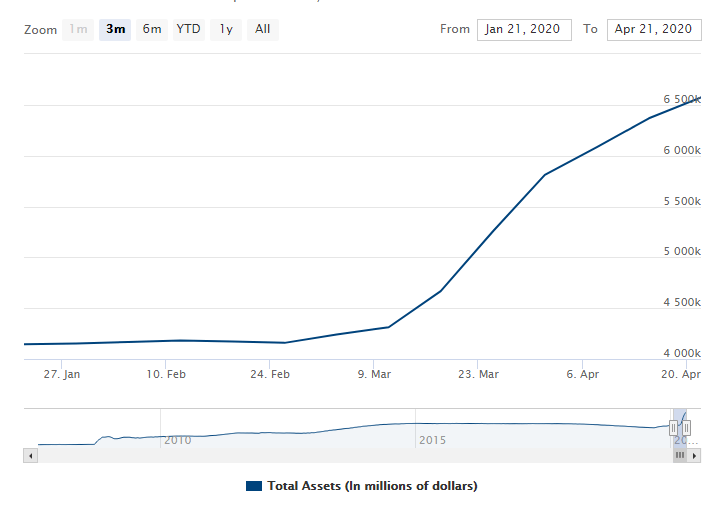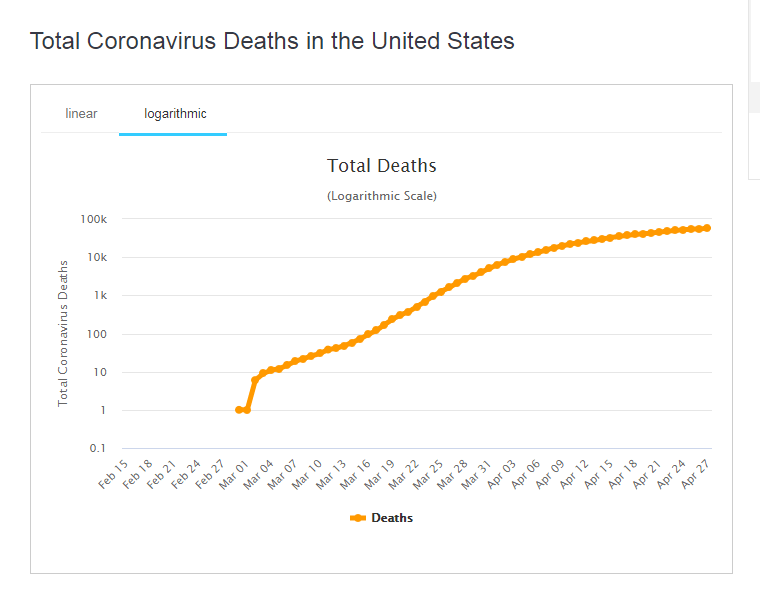- The S&P has risen over 30% within a month, erasing more than half its losses.
- The move comes despite growing evidence of severe economic damage.
- Five charts explain the reasons are behind the move.
- Each reason for the rise has the potential to turn sour.
The S&P 500 stock index is up over 30% from the lows, staging an impressive recovery. The rise comes as over 26 million Americans lost their jobs, and more will come at a rapid pace. Retail sales plunged by over 8% in March – despite frantic shopping for groceries – and forward-looking service sector surveys fell to record lows. Coronavirus and the lockdowns are taking a heavy toll on the economy.
What is going on? The following five charts explain the move and why S&P 500 may tumble down.
1) Fed fueling the rally (reached its limits?)
Perhaps the most significant upside driver has been abundant monetary stimulus, especially in the form of Quantitative Easing – money printing. The Federal Reserve's balance sheet has surpassed the $6.5 trillion mark, up from just over $4 trillion before the crisis hit.
The post-crisis peak stood at roughly $4.5 trillion after several rounds of QE that lasted years. Some of the $2.5 trillion of new money created within six weeks spilled into equity markets and certainly helped boost sentiment.
The Fed has thrown the kitchen sink, buying debt of "fallen angels" – junk bonds – and also expanded its purchase of municipal debt. It may have reached its limits, and without a further supply of Fed funds, shares may turn south.
Source: Federal Reserve
2) Massive focal stimulus (but there is bailout fatigue)
The government has also been active in supplying fiscal stimulus, pumping money into the economy. Apart from helping consumers and businesses, the funds also support the stock market. While the US has not pledged as many funds – compared to its Gross Domestic Product – the majority of cash deployed is in direct payments. That differs from other countries that opted for deferrals and loans.
However, after several rounds of bipartisan agreements, cracks are opening. Lawmakers and the public still have the 2008-2009 crisis in mind, where sometimes unworthy companies were bailed out. Disagreements over help to states and the oil industry are already showing. The US economy is reeling and probably needs more support for small businesses and individuals who lost their jobs and the accompanying health insurance.
Without imminent new stimulus in the face of a worsening economic situation, investors may shy away. The government may always directly buy stocks, but that remains a remote option.
Source: Bruegel, via Statistica
3) Fear was exaggerated (but also the current greed)
What goes up, must come down, and the other way around. The S&P 500 lost around a third of its value within less than a month and then gained nearly the same amount in percentage terms, which is insufficient to reconquer the highs.
Fear from coronavirus carnage may have been exaggerated, but also greed in light of fiscal and monetary stimulus may have gone too far. Markets tend to overreact in both directions. As the dust settles and the depth of the damage is realized, the pendulum may swing lower. Perhaps it will be without the fanfare of the previous crash, but it is hard to defy gravity in the face of the grave situation.
4) Stronger stocks are carrying the weak (for now)
The S&P 500 is comprised of 500 shares, not all of the equal size. At the time Goldman Sachs performed the research, the S&P 500 was 17% below its record high in February, but the media stock traded some 28% off the peak. That means that a small number of shares – such as Amazon, which is having a good crisis – are carrying the weight.
Such disparities have been seen in the past, but eventually resulted in sharp downturns. As researchers from the bank state on the graph, these shape declines in market breadth have often signaled severe recessions. The momentum may reverse sooner than later, and stronger stocks may be carried down the majority of weaker ones.
Source: Gold Sachs. Hat tip, Jonathan Ferro, via Twitter.
5) Some hope (but beware of a second wave
The US has succeeded in flattening the curve with the absolute number of total deaths falling to an average pace of under 2,000 per day. The logarithmic chart below shows how the world's largest economy managed to slow the spread, and a gradual lifting of restrictions is warranted. That also provides hope for equity bulls.
Experts recommend easing stay-at-home orders with means to contain new cases – testing and contact tracing quickly. With rapid probes, people carrying the virus and those they may have infected can be rapidly isolated and prevent a further spread.
However, the US is far from reaching the recommended level of daily tests or hire enough people to trace contacts. Moreover, pressure from President Donald Trump may push some governors to move too quickly. Germany, where testing has been lauded worldwide, the easing of lockdown measures raised the infection rate, and the government is considering reimposing restrictions.
A second shelter-in-place order is far worse than extending existing limits to movement as it may deal a blow to consumer and business confidence.
Source: WorldInfoMeter
Conclusion
Five factors are boosting S&P to a remarkable rally from the lows, but all may prove ephemeral, and stocks may turn back down.
More: Lack of leadership may lead to L-shaped economy, markets may suffer badly
Information on these pages contains forward-looking statements that involve risks and uncertainties. Markets and instruments profiled on this page are for informational purposes only and should not in any way come across as a recommendation to buy or sell in these assets. You should do your own thorough research before making any investment decisions. FXStreet does not in any way guarantee that this information is free from mistakes, errors, or material misstatements. It also does not guarantee that this information is of a timely nature. Investing in Open Markets involves a great deal of risk, including the loss of all or a portion of your investment, as well as emotional distress. All risks, losses and costs associated with investing, including total loss of principal, are your responsibility. The views and opinions expressed in this article are those of the authors and do not necessarily reflect the official policy or position of FXStreet nor its advertisers. The author will not be held responsible for information that is found at the end of links posted on this page.
If not otherwise explicitly mentioned in the body of the article, at the time of writing, the author has no position in any stock mentioned in this article and no business relationship with any company mentioned. The author has not received compensation for writing this article, other than from FXStreet.
FXStreet and the author do not provide personalized recommendations. The author makes no representations as to the accuracy, completeness, or suitability of this information. FXStreet and the author will not be liable for any errors, omissions or any losses, injuries or damages arising from this information and its display or use. Errors and omissions excepted.
The author and FXStreet are not registered investment advisors and nothing in this article is intended to be investment advice.
Recommended Content
Editors’ Picks

EUR/USD treads water just above 1.0400 post-US data
Another sign of the good health of the US economy came in response to firm flash US Manufacturing and Services PMIs, which in turn reinforced further the already strong performance of the US Dollar, relegating EUR/USD to the 1.0400 neighbourhood on Friday.

GBP/USD remains depressed near 1.2520 on stronger Dollar
Poor results from the UK docket kept the British pound on the back foot on Thursday, hovering around the low-1.2500s in a context of generalized weakness in the risk-linked galaxy vs. another outstanding day in the Greenback.

Gold keeps the bid bias unchanged near $2,700
Persistent safe haven demand continues to prop up the march north in Gold prices so far on Friday, hitting new two-week tops past the key $2,700 mark per troy ounce despite extra strength in the Greenback and mixed US yields.

Geopolitics back on the radar
Rising tensions between Russia and Ukraine caused renewed unease in the markets this week. Putin signed an amendment to Russian nuclear doctrine, which allows Russia to use nuclear weapons for retaliating against strikes carried out with conventional weapons.

Eurozone PMI sounds the alarm about growth once more
The composite PMI dropped from 50 to 48.1, once more stressing growth concerns for the eurozone. Hard data has actually come in better than expected recently – so ahead of the December meeting, the ECB has to figure out whether this is the PMI crying wolf or whether it should take this signal seriously. We think it’s the latter.

Best Forex Brokers with Low Spreads
VERIFIED Low spreads are crucial for reducing trading costs. Explore top Forex brokers offering competitive spreads and high leverage. Compare options for EUR/USD, GBP/USD, USD/JPY, and Gold.


-637237475265106170.png)

